#rosaura revueltas
Explore tagged Tumblr posts
Text


Propaganda
Cyd Charisse (The Bandwagon, Brigadoon, Singin’ in the Rain)—LEGS LEGS LEGS I would sell my soul for the legs of Cyd Charisse - she oozed style and glamour and sex appeal!! And she could DANCE! She was dancing next to the greats - Gene Kelly, Fred Astaire but they are never who you're looking at because why would you when you can look at her. I will only sit through too long ballet breaks for her. If there was any woman who you could call sex on legs it was her. These dances are everything to meeee (she comes in at the minute mark) and this dance too of course is iconic. In the words of Fred Astaire 'When you've danced with Cyd Charisse you stay danced with'
Rosaura Revueltas (Salt of the Earth)—She was a Mexican actress who is best known for starring in salt of the earth, an amazing pro-labor movie made by blacklisted filmmakers. She also starred in the Mexican remake of madchen in uniform, one of the first representations of lesbian romance onscreen. She was really dedicated to making progressive films and was also such an incredible actress and artist I truly believe more people should know about her and her work.
This is round 3 of the tournament. All other polls in this bracket can be found here. Please reblog with further support of your beloved hot sexy vintage woman.
[additional propaganda submitted under the cut.]
Cyd Charisse:
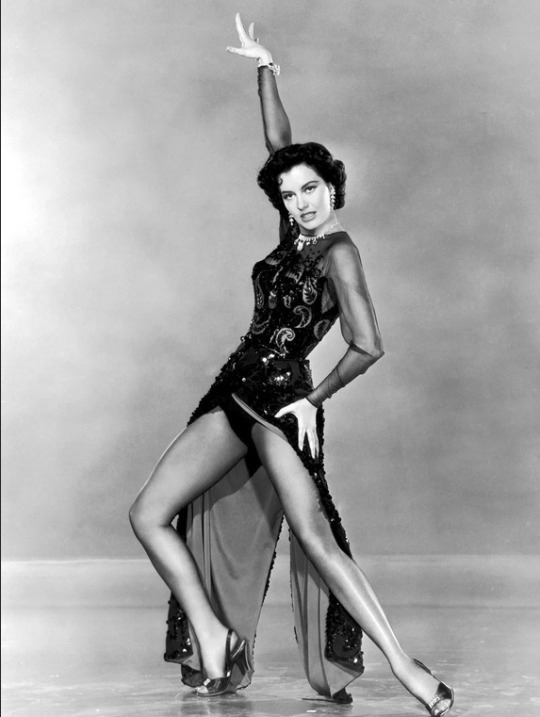
Arguably the Best female dancer of her time, she supposedly insured her legs for $5 million dollars. Stole the show whenever she had a dance number, even if she went uncredited. Musicals started to go out of fashion so unfortunately she didn't have as many big roles as she should have, but those she did are unforgettable. The Broadway Melody number in Singin' in the Rain - the green dress!
Incredibly, Cyd Charisse only started learning to dance as a rehab exercise to strengthen her body after a childhood bout of polio. She was in high demand as a dance partner, Fred Astaire called her beautiful dynamite and said "When you've danced with her, you stayed danced with". She was one of a few leading ladies to dance with both Astaire and Kelly, declaring them both delicious. Kelly apparently was stronger, while Astaire was more coordinated. She also said her husband would always know who she had been dancing with because Kelly left her bruised, while Astaire didn't leave a mark. She's better known for her dance numbers today, but she was a leading lady in her time! Her Scottish accent in Brigadoon leaves a lot to be desired, but compared to the other actors in the movie, it's almost good. She appeared in The Harvey Girls alongside Judy Garland and Angela Lansbury in her first speaking role, but she really burst onto the scene with Singin' in the Rain and her infamous Broadway Melody Ballet number with Gene Kelly (no one could handle a length of fabric like Cyd Charisse). She was brought in because Debbie Reynolds wasn't really a dancer and Kelly was notoriously a stickler about his Vision. After that she starred opposite Astaire in The Band Wagon, which was a bit of a flop but created some enduringly incredible dance numbers. She went on to star in a number of MGM movies, and was one of the last of the Studio era stars to remain on contract. Since we've got up to 1970, I'm including her opening routine in The Silencers (1966) to show just how long she was making a splash - she's into her 40s here and still a siren:
youtube
and of course, the iconic Broadway Melody Ballet -
youtube
Photos do not do Cyd Charisse justice, unfortunately, because she is at her hottest while dancing, which she was exquisitely good at. Just go watch her first number in Singin' in the Rain, in that green dress; nothing I could say here will be more convincing that that.

She had amazing legs, and she knew how to use them! You probably know her best from the dream sequence in Singin' In The Rain. She was such a stunning dancer, and all her dance scenes are hard to look away from.
Dancing in the Dark clip:
youtube
She's an amazing dancer and my favorite from the period. Here's her and Fred Astaire in the Band Wagon:
youtube
I just like a woman who's there to be really incredibly good at dancing.
One of the most talented female dancers in Hollywood history, but what sets her apart from other competitors for that title is that she...umm...well let's be blunt, she was the dancer who put sex into it. The one who said "Hey, you know that A+ leg tone that naturally develops from doing this for a living? Why don't I let people see that? Like at every opportunity?" She reportedly insured her legs for five million dollars after hitting it big, which just goes to show that fame makes you crazy. It should have been ten million.

She could pirouette in pointes or tear it up in taps. Fred Astaire called her "beautiful dynamite" and wrote, "That Cyd! When you've danced with her you stay danced with." Gene Kelly partnered with her three times. Her legs were (reportedly) insured for $5 million in 1952 ($57.8 million in 2024 dollars)! Everyone in this poll will be iconic, but for raw physical grace, Cyd is up there with the best.

Legs for days, beautiful dancer in the most iconic scenes of Singin in the Rain. She's glorious. As some guys sung to her in It's Always fair weather, 'baby you knock me out!'

No additional propaganda was submitted for Rosaura Revueltas. Please send me some.
263 notes
·
View notes
Text
Remembering Salt of the Earth star Rosaura Revueltas on the anniversary of her death.





R.I.P. (1910 - 1996)
#rest in peace#rosaura revueltas#salt of the earth#social realist film#actress#classic film#hollywood blacklist#1950s film#movie art#art#drawing#movie history
2 notes
·
View notes
Photo
⬆️⬆️⬆️
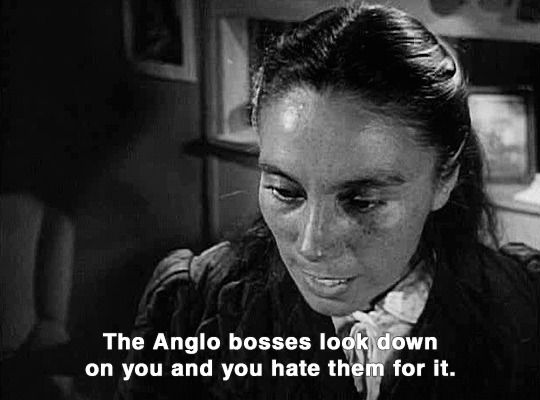
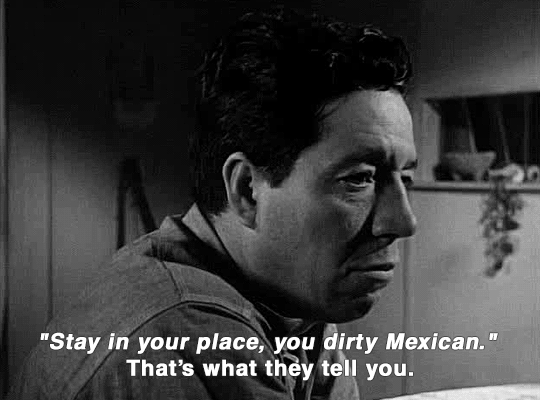
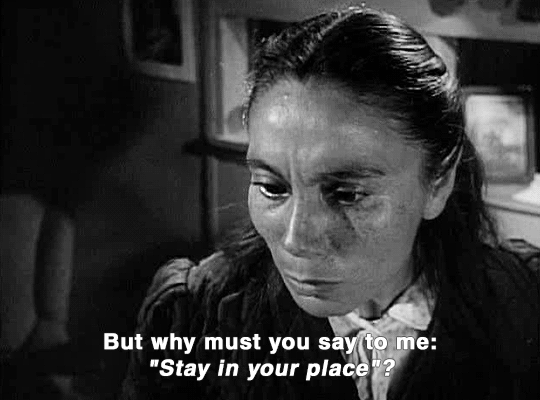
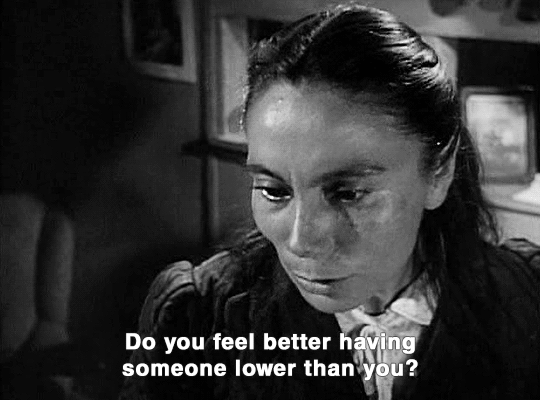
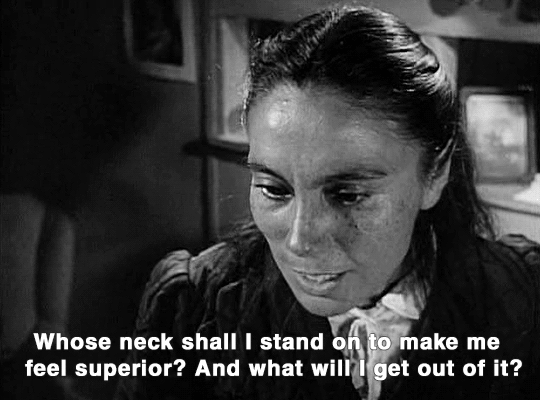


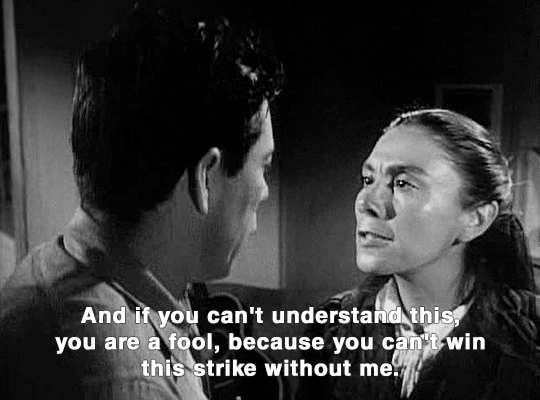
Salt of the Earth (1954), dir. Herbert J. Biberman
#salt of the earth#salt of the earth 1954#herbert j. biberman#film#michael wilson#rosaura revueltas#the hollywood ten#the hollywood blacklist#gifs#filmedit
120K notes
·
View notes
Text

Rosaura Revueltas en Islas Marías (Emilio Fernández, 1951)
0 notes
Photo
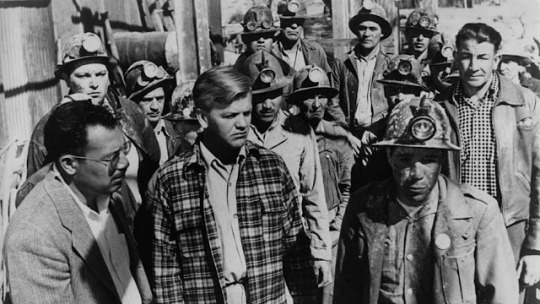
Striking miners in Salt of the Earth (Herbert J. Biberman, 1954)
Cast: Will Geer, David Bauer, David Sarvis, Mervin Williams, Rosaura Revueltas, E.A. Rockwell, William Rockwell, Juan Chacón, Henrietta Williams. Screenplay: Michael Wilson. Cinematography: Stanley Meredith, Leonard Stark. Film editing: Joan Laird, Ed Spiegel. Music: Sol Kaplan. Although it holds one's interest and is a largely successful American attempt to imitate the neo-realism of postwar Italian directors like Roberto Rossellini and Vittorio De Sica, Salt of the Earth is not, I think, a great movie. The acting is amateurish -- necessarily so, because most of the actors are in fact amateurs -- and the plotting is tendentious, with "bad guys" who are given no depth of characterization. But I think it is, perhaps more now than ever, an essential movie. It tells the story of a miners' strike in New Mexico that's based on an actual 1951 strike by the workers of the Empire Zinc Company. The point of view is mostly that of a Mexican-American married couple, the miner Ramon Quintero (Juan Chacón) and his wife, Esperanza (Rosaura Revueltas). When the miners go on strike for better working conditions, especially to put Latino workers on a par with the Anglos, the company invokes the Taft-Hartley Act, enjoining the striking workers from picketing. But the miners' wives take up the cause, in part because they want to improve the standards of the company-owned housing they live in. The film develops a tension not only between workers and management but also between Juan, who clings to a traditional machismo, and Esperanza, who is pregnant but insists on joining the other women on the picket line, where they are subjected to harassment and threats of violence, and are briefly thrown in jail. The story has a happy ending, with the miners and their wives triumphing, but the film itself was denounced as communist propaganda, and its director, Herbert J. Biberman, was one of the Hollywood Ten who were cited for contempt of Congress for refusing to testify before the House Un-American Activities Committee. Biberman went to jail for six months. The film's screenwriter, Michael Wilson, was blacklisted, though he continued to work on films sub rosa: His work on the screenplay for The Bridge on the River Kwai (David Lean, 1957) won an Oscar, though only Pierre Boulle, who neither spoke nor wrote English, was credited. In 1984, the Academy posthumously restored Wilson's credit on the film and his Oscar, as it later also restored his credits on the Oscar-nominated screenplays for Lawrence of Arabia (David Lean, 1962) and Friendly Persuasion (William Wyler, 1956). Salt of the Earth itself got a kind of belated recognition in 1992 when the Library of Congress chose it for inclusion in the National Film Registry. And the story of the treatment of its filmmakers could serve as an object lesson in an era when resurgent racism and anti-feminism threaten to turn the clock back to the era in which the film was made.
3 notes
·
View notes
Video
⛏️Rosaura Revueltas, Juan Chacon | Salt Of The Earth (1953) | Full Movie...
Salt of the Earth is a 1954 US drama movie written by Michael Wilson, directed by Herbert J. Biberman, and produced by Paul Jarrico. The film was called 'subversive' and blacklisted because the International Union of Mine, Mill, and Smelter Workers sponsored it and many blacklisted Hollywood professionals helped produce it. The producers cast only five professional actors. The rest were locals from Grant County, New Mexico, or members of the International Union of Mine, Mill and Smelter Workers, Local 890, many of whom were part of the strike that inspired the plot. At the time that the movie was released it was not well received, The film is superb, however, and gets 100% from Rotten Tomatoes. Cast Professional actors Rosaura Revueltas as Esperanza Quintero Will Geer as Sheriff David Bauer as Barton (as David Wolfe) Mervin Williams as Hartwell David Sarvis as Alexander Never miss a video. Join the channel so that Mr. P can notify you when new videos are uploaded: https://www.youtube.com/@nrpsmovieclassics
0 notes
Text
Se presentó en la BUAP el libro Los Revueltas. Biografía de una familia
Se presentó en la @BUAPoficial el libro Los Revueltas. Biografía de una familia
Agencias, Ciudad de México.- La historia de una familia mexicana, cuyos integrantes destacaron en alguna área de las bellas artes y contribuyeron activamente al desarrollo cultural de México durante el siglo XX, se plasma en el libro Los Revueltas. Biografía de una familia, escrito por Rosaura Revueltas y el cual se presentó en la Librería BUAP del Complejo Cultural Universitario. En seis…

View On WordPress
0 notes
Text
youtube
Salt of the Earth (1954) / drama film / Rosaura Revueltas, Will Geer, David Wolfe
0 notes
Photo

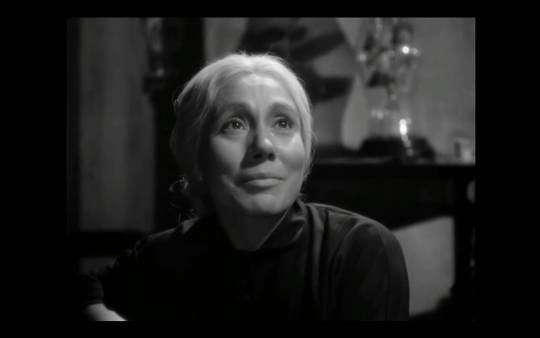
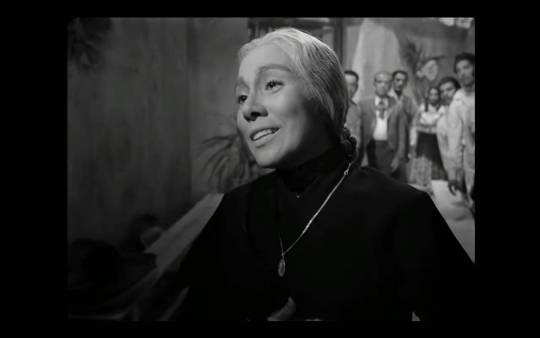


Rosaura Revueltas es Máma Juanita – Un día de vida (1950)
30 notes
·
View notes
Photo

Seen in 2020:
Salt of the Earth (Herbert J. Biberman), 1954
12 notes
·
View notes
Text


Propaganda
Rosaura Revueltas (Salt of the Earth)—She was a Mexican actress who is best known for starring in salt of the earth, an amazing pro-labor movie made by blacklisted filmmakers. She also starred in the Mexican remake of madchen in uniform, one of the first representations of lesbian romance onscreen. She was really dedicated to making progressive films and was also such an incredible actress and artist I truly believe more people should know about her and her work.
Romy Schneider (Mädchen in Uniform, la piscine, 10:30pm Summer)— Such a beautiful woman and she has the full range: she can be anything from cute to seductive to tough - and all the time she's elegant. Also you just gotta love how she left Germany and her fame there behind to start all over in France, wanting to break free from always being typecast as the cute (royal) girl. She put an extreme amount of energy into learning French perfectly in just a few weeks so she could prove herself by starring in a theatre play by Luchino Visconti (who put enormous pressure on her). Anyway, everything went well and she could continue her career in French cinema with more complex and challenging roles.
This is round 1 of the tournament. All other polls in this bracket can be found here. Please reblog with further support of your beloved hot sexy vintage woman.
[additional propaganda submitted under the cut]
Romy Schneider:

She only had a brief stunt in Hollywood but starred in many French movies plus of course the role I know her best for, Empress Elisabeth of Austria in the movies Sissi. I see those eyes, I see that smile and of course her voice and just, perfection. Warner Bros. planned to do a movie about her, which was sadly cancelled but there is also a musical about her life, because she is just that great. (According to Wikipedia she told the author of her biography that she was what we would call bisexual these days, but because the source is french I can't confirm it)
need to show the backstage pic of her with alain delon because it makes me insane:

I'm submitting her to have some french representation in the poll, because we got our fair share of pretty vintage ladies over here (well, she was german, but she later acquired french citizenship). And also, just. Look at her.

She’s hottt
Linked gifset
She played in a lesbian movie! During the 1950s! Gif here [link] She worked for some of the best directors : Orson Welles, Otto Preminger, Luchino Visconti, Joseph Losey etc
She will always be Empress Sissi to me.

#romy schneider#rosaura revueltas#big day for the madchen in uniform fans. this was accidental#hotvintagepoll#fuck that old woman#ladies 1
288 notes
·
View notes
Text
On April 4, 1957, Saly of the Earth debuted in the Netherlands.








#salt of the earth#herbert j. biberman#michael wilson#rosaura revueltas#esperanzo quintero#hollywood blacklist#drama film#social realism#political drama#feminist film#censored film#movie art#art#drawing#movie history#pop art#modern art#pop surrealism#cult movies#portrait#cult film
0 notes
Photo
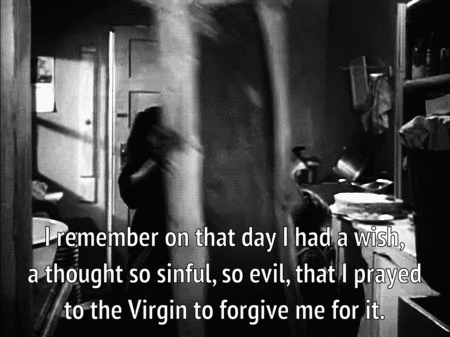


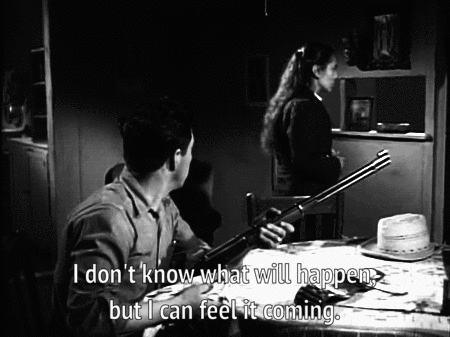

Esperanza Quintero + The Virgin Mary
Salt of the Earth (1954)
#salt of the earth#rosaura revueltas#salt of the earth 1954#classic film#i made minor changes to the dialogue to make it understandable/fit the gif better#im gonna make more of these. basically just on esperanza but the whole film is brilliant#i really liked this motif even tho it's minor#really good reflection of her character growth
41 notes
·
View notes
Photo
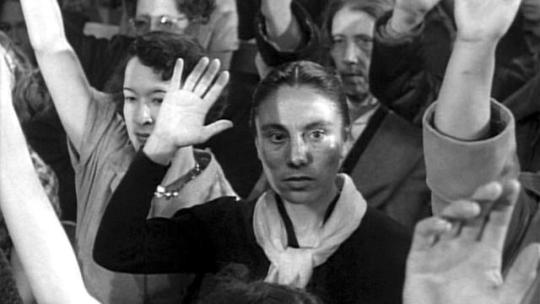
Salt of the Earth (1954)
The House Un-American Activities Committee (HUAC) played an important hand in Hollywood history by finding ten directors and writers in contempt for refusing to testify before the committee. Three of those ten figures – director Herbert J. Biberman, producer Paul Jarrico, and writer Michael Wilson – worked on an independent film entitled Salt of the Earth, a story of a largely Mexican-American mining community in New Mexico that strikes against the corporation virtually all the men work for, demanding more humane working conditions like their fellow white co-workers enjoy. As one might imagine, Salt of the Earth was troubled with difficulties even in pre-production and, as if all of those obstacles were not already enough (more on those later in this piece), this is the only film that has ever been blacklisted. Major American movie theater chains, spooked by any potential governmental sanctions, refused to show the film upon initial release. A limited run in thirteen North American theaters followed.
Salt of the Earth’s low-budget limitations are apparent: the acting is awkward, the editing subpar. What is remarkable about this film is that its principal creators – Biberman, Jarrico, and Wilson – could have easily made this film as a metaphor for how they were treated. Many films written by blacklisted screenwriters (Dalton Trumbo comes to mind) attempt to insert the stories of their blacklisting into the narrative, forming intentional parables of their struggles into the screenplays. That is not the case in Salt of the Earth, which was based on the 1951 Empire Zinc strike. As one always finds in narrative movies on labor movements, there are conflicts between the laborers and executives. Here, there are also racial dynamics from the onset. So too are commentaries on machismo culture prevalent in Mexican-American (across Latin America, really) communities, and how intersectionality and feminism strengthen the miners’ strike.
Esperanza Quintero (Rosaura Revueltas) is pregnant with her third child and married to Ramon (Juan Chacón). Their marriage could be better, as Ramon is intimidating and emotionally dominant and they live in a basic house owned by the local mining company. Ramon works in the nearby mine and, after a preventable workplace accident, he – with the backing of almost all his fellow Latino union members – votes to strike for equal working conditions with their white counterparts. The corporation refuses to negotiate; the miners’ strike becomes a cause célèbre of labor organizations, civil rights groups, and concerned citizens from across the country. Eventually the company wins a Taft-Hartley injunction from the federal government – meaning that if any of the strikers persist, they will be arrested. But at the next union meeting, the miners’ wives and other women of the community note the existence of a loophole and volunteer themselves to strike on behalf of the miners. It is Esperanza, without any political voice until now, who is among those who speaks up. Don’t demean yourselves like this, say some of the men. Women should not be involved in political affairs, some add.
In that crucial scene, the chairman of the labor union – sensing an opportunity to prolong the strike and showing the company (and the nation) a united front – adjourns the union meeting and calls for an impromptu community meeting. The women are almost unanimous in their opinions and are joined by enough men to outnumber those disapproving of this proposal. This is the most moving scene in Salt of the Earth – already weakened by far too much exposition and narration from Esperanza rather than letting the actions and images command the story. These Latina women, perhaps too scared to be expressly political in their own homes let alone in public, remind the men (and the audience) that they suffer from the company’s unfair practices as well. The strike, which has gone on for months, is making it difficult to feed families and buy necessities. Salt of the Earth, in scenes where Esperanza and Ramon are fighting amongst each other about the aims and duration of the strike, captures the tension that one infers is playing out in homes throughout the area. Sixty years after Biberman’s film was first released, the idea of women participating in any form of civic engagement no longer feels radical. But for when Salt of the Earth was released, how astonishing it must have been to see the sight of Latina women – joined by women of other races looking to show solidarity – taking it upon themselves to organize, mobilize, and vocalize.
That acknowledgement of feminism and the power of intersectional politics in a social protest movement is Salt of the Earth’s greatest strength. While struggling to find a place for her political voice, Esperanza also struggles to find a place at home – where the company owns the house, the furnishings, and probably the utilities as well. Her understanding of the world – along with her lady friends – is limited to what they talk to each other about, as well as what they overhear on the radio all day. The women, together, free themselves from the confines of their homes, their unbalanced familial commitments, their small worlds where mobility and progress are just abstract talking points. Even now, it seems that Hollywood is awaiting a film inspired by the political resolve of the non-white women found in Salt of the Earth. There really is no excuse anymore because the film – now in the public domain because its copyright was not renewed in 1982 and part of the Library of Congress’ National Film Registry (class of 1992) – is freely available. And no, 2000′s One of the Hollywood Ten (a narrative movie about Herbert Biberman’s attempts to make Salt of the Earth; Biberman is played Jeff Goldblum) does not count.
It is almost documentary-like at times (the mediocre cinematography and, as mentioned before, its rough editing and poor acting outside of Revueltas lets that down), certainly taking a page from the Italian neorealists. Like Italian neorealism, Salt of the Earth employs many non-professional actors (including Chacón, who was the real-life union’s local president) as extras or bit players – some of whom participated in the Empire Zinc strike. Only five professional actors starred in the film: Revueltas (who primarily worked in Mexican cinema; 1952′s Soledad’s Shawl and 1953′s Sombrero), Will Geer (1950′s Winchester ‘73 and the grandfather from The Waltons) as the sheriff, David Wolfe (1949′s Bagdad), Mervin Williams (an extra in various films, including 1948′s The Naked City), and David Sarvis.
Salt of the Earth’s socialist themes, unlike its feminism, interferes with the film. Where the latter never strays into patronizing pontification, the former does. The lack of nuance to how the strikers are approaching the company and vice versa from class- and employee-employer dynamics does well to preach to the converted, but little else (films adopting politics I sympathize with are well and good, but I admit to having little patience for agitprop, which tends to demonize political opponents and which this film comes close to becoming).
Financing for the film was provided the International Union of Mine Mill and Smelter Workers, which had been removed from the Congress of Industrial Organizations (CIO) in 1950 due to suspected communist leanings. With money limited and even violent reprisals against cast and crew from residents of the New Mexico towns where the film was being shot, Salt of the Earth’s production story is the stuff of anxiety attacks and nightmares. Film processing laboratories – largely owned by the major studios – refused to work on the film’s post-production. Thus, the exposed footage was sent to labs under a different name – Vaya Con Dios (“Go with God”) – in order to be completed. Salt of the Earth was also the only American film to open in the People’s Republic of China between 1950 and 1979.
Rosaura Revueltas, after the film’s release, was accused of being a communist. She was later detained and deported by the Immigration and Naturalization Service (INS), never to work again in American cinema. It took longer than it should for American cinephiles and the federal government to accept Salt of the Earth for what it is and what, in this movie, Revueltas represented. As Esperanza (“Hope”, for all non-Spanish speakers), she is at first overcome with fear of reprisals from the white executives and her husband. Through her friends and within herself, she finds the strength to take action, to express her political voice.
My rating: 7/10
^ Based on my personal imdb rating. My interpretation of that ratings system can be found here.
NOTE: Salt of the Earth can be viewed here (it is in the public domain).
#Salt of the Earth#Herbert J. Biberman#Rosaura Revueltas#Will Geer#David Wolfe#Mervin Williams#David Sarvis#Juan Chacon#Henrietta Williams#Paul Jarrico#Michael Wilson#TCM#My Movie Odyssey
2 notes
·
View notes
Photo



• ROSAURA REVUELTAS •
C I U D A D M E X I C O
T h ’ P i t s o t l |2 0 2 1
0 notes